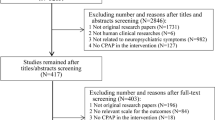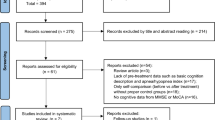Abstract
Neurocognitive dysfunction is a major clinical consequence in patients with obstructive sleep apnea syndrome (OSAS). The effects of continuous positive airway pressure (CPAP) treatment, as the gold standard of treatment in OSAS, on this major complication are controversial. The duration and compliance of CPAP are thought to be important factors but evidence is lacking. This study is designed to evaluate the effects of immediate (one night), long-term (3 months) influence and the compliances of CPAP treatment on the neurocognitive function in OSAS patients. We enrolled newly diagnosed severe OSAS patients. Neurocognitive function test battery, CANTAB (Cambridge Neuropsychological Test Automated Battery), was performed before, one night and 3 months of CPAP treatment. Patients with CPAP compliance rate ≥ 70 % and < 50 % were grouped into good and poor adherence subjects, respectively. Fourteen patients were enrolled in final analyses. Six of them were in poor compliant group. Improvements in attention domain were found in all subjects after one-night treatment and maintained till three-month follow-up. Additional improvements in some attention performances and visual memory performances were gained only after three-month treatment. Significant changes of decision-making and response control function were found between good and poor compliance groups after three-month treatment. CPAP can improve some neurocognitive function at the very first day used. Longer treatment of CPAP can additionally improve some other neurocognitive functions. Compliance of CPAP has influence on the recovery of neurocognitive functions in patients with severe OSAS.


Similar content being viewed by others
References
Young T, Palta M, Dempsey J, Skatrud J, Weber S, Badr S (1993) The occurrence of sleep-disordered breathing among middle-aged adults. New Engl J Med 328(17):1230–1235. doi:10.1056/NEJM199304293281704
Saunamaki T, Jehkonen M (2007) A review of executive functions in obstructive sleep apnea syndrome. Acta Neurol Scand 115(1):1–11. doi:10.1111/j.1600-0404.2006.00744.x
Sassani A, Findley LJ, Kryger M, Goldlust E, George C, Davidson TM (2004) Reducing motor-vehicle collisions, costs, and fatalities by treating obstructive sleep apnea syndrome. Sleep 27(3):453–458
Engleman HM, Douglas NJ (2004) Sleep. 4: sleepiness, cognitive function, and quality of life in obstructive sleep apnoea/hypopnoea syndrome. Thorax 59(7):618–622
Bradley TD, Floras JS (2009) Obstructive sleep apnoea and its cardiovascular consequences. Lancet 373(9657):82–93. doi:10.1016/S0140-6736(08)61622-0
Phillips B, Kryger MH (2005) Management of obstructive sleep apnea syndrome: overview. In: Kryger MH, Roth T, Dement WC (eds) Principles and practice of sleep medicine. Elsevier Saunders, Philadelphia, pp 1109–1121
Marin JM, Carrizo SJ, Vicente E, Agusti AG (2005) Long-term cardiovascular outcomes in men with obstructive sleep apnoea-hypopnoea with or without treatment with continuous positive airway pressure: an observational study. Lancet 365(9464):1046–1053. doi:10.1016/S0140-6736(05)71141-7
Weaver TE, Sawyer AM (2010) Adherence to continuous positive airway pressure treatment for obstructive sleep apnoea: implications for future interventions. Indian J Med Res 131:245–258
Sanchez AI, Martinez P, Miro E, Bardwell WA, Buela-Casal G (2009) CPAP and behavioral therapies in patients with obstructive sleep apnea: effects on daytime sleepiness, mood, and cognitive function. Sleep Med Rev 13(3):223–233. doi:10.1016/j.smrv.2008.07.002
Lojander J, Kajaste S, Maasilta P, Partinen M (1999) Cognitive function and treatment of obstructive sleep apnea syndrome. J Sleep Res 8(1):71–76
Henke KG, Grady JJ, Kuna ST (2001) Effect of nasal continuous positive airway pressure on neuropsychological function in sleep apnea-hypopnea syndrome. A randomized, placebo-controlled trial. Am J Respir Crit Care Med 163(4):911–917
Biegler KA, Chaoul MA, Cohen L (2009) Cancer, cognitive impairment, and meditation. Acta Oncol 48(1):18–26. doi:10.1080/02841860802415535
Zuccala G, Cattel C, Manes-Gravina E, Di Niro MG, Cocchi A, Bernabei R (1997) Left ventricular dysfunction: a clue to cognitive impairment in older patients with heart failure. J Neurol Neurosurg Psychiatry 63(4):509–512
Koushik NS, McArthur SF, Baird AD (2010) Adult chronic kidney disease: neurocognition in chronic renal failure. Neuropsychol Rev 20(1):33–51. doi:10.1007/s11065-009-9110-5
McAndrews MP, Farcnik K, Carlen P, Damyanovich A, Mrkonjic M, Jones S, Heathcote EJ (2005) Prevalence and significance of neurocognitive dysfunction in hepatitis C in the absence of correlated risk factors. Hepatology 41(4):801–808. doi:10.1002/hep.20635
Crews WD, Jefferson AL, Bolduc T, Elliott JB, Ferro NM, Broshek DK, Barth JT, Robbins MK (2001) Neuropsychological dysfunction in patients suffering from end-stage chronic obstructive pulmonary disease. Arch Clin Neuropsychol (the official journal of the National Academy of Neuropsychologists) 16(7):643–652
Kadan-Lottick NS, Zeltzer LK, Liu Q, Yasui Y, Ellenberg L, Gioia G, Robison LL, Krull KR (2010) Neurocognitive functioning in adult survivors of childhood non-central nervous system cancers. J Nat Cancer Inst 102(12):881–893. doi:10.1093/jnci/djq156
Conti F, Alessandri C, Perricone C, Scrivo R, Rezai S, Ceccarelli F, Spinelli FR, Ortona E, Marianetti M, Mina C, Valesini G (2012) Neurocognitive dysfunction in systemic lupus erythematosus: association with antiphospholipid antibodies, disease activity and chronic damage. PLoS ONE 7(3):e33824. doi:10.1371/journal.pone.0033824
Kushida CA, Littner MR, Morgenthaler T, Alessi CA, Bailey D, Coleman J Jr, Friedman L, Hirshkowitz M, Kapen S, Kramer M, Lee-Chiong T, Loube DL, Owens J, Pancer JP, Wise M (2005) Practice parameters for the indications for polysomnography and related procedures: an update for 2005. Sleep 28(4):499–521
Chen NH, Johns MW, Li HY, Chu CC, Liang SC, Shu YH, Chuang ML, Wang PC (2002) Validation of a Chinese version of the Epworth sleepiness scale. Qual Life Res (an international journal of quality of life aspects of treatment, care and rehabilitation) 11(8):817–821
De Luca CR, Wood SJ, Anderson V, Buchanan JA, Proffitt TM, Mahony K, Pantelis C (2003) Normative data from the CANTAB. I: development of executive function over the lifespan. J Clin Exp Neuropsychol 25(2):242–254. doi:10.1076/jcen.25.2.242.13639
Lange KW, Robbins TW, Marsden CD, James M, Owen AM, Paul GM (1992) L-dopa withdrawal in Parkinson’s disease selectively impairs cognitive performance in tests sensitive to frontal lobe dysfunction. Psychopharmacology 107(2–3):394–404
Sahakian BJ, Owen AM, Morant NJ, Eagger SA, Boddington S, Crayton L, Crockford HA, Crooks M, Hill K, Levy R (1993) Further analysis of the cognitive effects of tetrahydroaminoacridine (THA) in Alzheimer’s disease: assessment of attentional and mnemonic function using CANTAB. Psychopharmacology 110(4):395–401
Owen AM, Roberts AC, Polkey CE, Sahakian BJ, Robbins TW (1991) Extra-dimensional versus intra-dimensional set shifting performance following frontal lobe excisions, temporal lobe excisions or amygdalo-hippocampectomy in man. Neuropsychologia 29(10):993–1006
Lowe C, Rabbitt P (1998) Test/re-test reliability of the CANTAB and ISPOCD neuropsychological batteries: theoretical and practical issues. Cambridge neuropsychological test automated battery. International study of post-operative cognitive dysfunction. Neuropsychologia 36(9):915–923
Kribbs NB, Pack AI, Kline LR, Smith PL, Schwartz AR, Schubert NM, Redline S, Henry JN, Getsy JE, Dinges DF (1993) Objective measurement of patterns of nasal CPAP use by patients with obstructive sleep apnea. Am Rev Respir Dis 147(4):887–895
Orth M, Duchna HW, Leidag M, Widdig W, Rasche K, Bauer TT, Walther JW, de Zeeuw J, Malin JP, Schultze-Werninghaus G, Kotterba S (2005) Driving simulator and neuropsychological [corrected] testing in OSAS before and under CPAP therapy. Eur Respir J 26(5):898–903. doi:10.1183/09031936.05.00054704
Yang Q, Phillips CL, Melehan KL, Rogers NL, Seale JP, Grunstein RR (2006) Effects of short-term CPAP withdrawal on neurobehavioral performance in patients with obstructive sleep apnea. Sleep 29(4):545–552
Antic NA, Catcheside P, Buchan C, Hensley M, Naughton MT, Rowland S, Williamson B, Windler S, McEvoy RD (2011) The effect of CPAP in normalizing daytime sleepiness, quality of life, and neurocognitive function in patients with moderate to severe OSA. Sleep 34(1):111–119
Monasterio C, Vidal S, Duran J, Ferrer M, Carmona C, Barbe F, Mayos M, Gonzalez-Mangado N, Juncadella M, Navarro A, Barreira R, Capote F, Mayoralas LR, Peces-Barba G, Alonso J, Montserrat JM (2001) Effectiveness of continuous positive airway pressure in mild sleep apnea-hypopnea syndrome. Am J Respir Crit Care Med 164(6):939–943
Engleman HM, Martin SE, Deary IJ, Douglas NJ (1997) Effect of CPAP therapy on daytime function in patients with mild sleep apnoea/hypopnoea syndrome. Thorax 52(2):114–119
Engleman HM, Kingshott RN, Wraith PK, Mackay TW, Deary IJ, Douglas NJ (1999) Randomized placebo-controlled crossover trial of continuous positive airway pressure for mild sleep apnea/hypopnea syndrome. Am J Respir Crit Care Med 159(2):461–467
Engleman HM, Martin SE, Deary IJ, Douglas NJ (1994) Effect of continuous positive airway pressure treatment on daytime function in sleep apnoea/hypopnoea syndrome. Lancet 343(8897):572–575
Engleman HM, Martin SE, Kingshott RN, Mackay TW, Deary IJ, Douglas NJ (1998) Randomised placebo controlled trial of daytime function after continuous positive airway pressure (CPAP) therapy for the sleep apnoea/hypopnoea syndrome. Thorax 53(5):341–345
Weaver TE, Maislin G, Dinges DF, Bloxham T, George CF, Greenberg H, Kader G, Mahowald M, Younger J, Pack AI (2007) Relationship between hours of CPAP use and achieving normal levels of sleepiness and daily functioning. Sleep 30(6):711–719
Aloia MS, Ilniczky N, Di Dio P, Perlis ML, Greenblatt DW, Giles DE (2003) Neuropsychological changes and treatment compliance in older adults with sleep apnea. J Psychosom Res 54(1):71–76
Aloia MS, Di Dio L, Ilniczky N, Perlis ML, Greenblatt DW, Giles DE (2001) Improving compliance with nasal CPAP and vigilance in older adults with OAHS. Sleep Breath 5(1):13–21. doi:10.1007/s11325-001-0013-9
Acknowledgments
This study is supported by the Chang Gung Medical Foundation, Grant number CMRPG 360501.
Conflict of Interest
The authors declare that they have no conflict of interest.
Author information
Authors and Affiliations
Corresponding author
Electronic supplementary material
Below is the link to the electronic supplementary material.
Rights and permissions
About this article
Cite this article
Lin, SW., Chou, YT., Kao, KC. et al. Immediate and Long-term Neurocognitive Outcome in Patients with Obstructive Sleep Apnea Syndrome After Continuous Positive Airway Pressure Treatment. Indian J Otolaryngol Head Neck Surg 67 (Suppl 1), 79–85 (2015). https://doi.org/10.1007/s12070-014-0777-4
Received:
Accepted:
Published:
Issue Date:
DOI: https://doi.org/10.1007/s12070-014-0777-4




